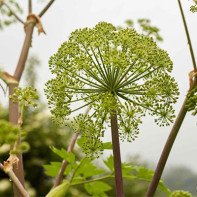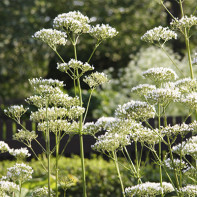Angelica: therapeutic properties and contraindications
A beautiful herbaceous plant called angelica, wolfsbane, pudonchnik, kuhtina, podranitsa, and even cannon. In scientific literature, its second name is woodpecker. There are 116 species of angelica in nature, of which only four are used for medicinal purposes: medicinal (it is characterized by the best effect), forest, swamp and Chinese.
- Chemical composition
- What it looks like and where it grows
- Gathering and storage
- What is the difference between angelica and milk thistle
- Therapeutic properties of angelica
- For women
- For men
- When losing weight
- Angelica in folk medicine
- Kinds of medicinal compositions
- Infusion
- Infusion
- Decoction
- Tea
- Oil of angelica: properties and contraindications
- Useful properties of angelica honey
- The use of angelica in cosmetology
- To reduce skin irritation
- For getting rid of fine lines
- Bath for firm and smooth skin
- Smoothing hair mask
- For lush hair
- Contraindications for use
Chemical Composition
Angelica is very pleasant and quite strong smelling. This fragrance gives it essential oil, which is present in all parts of the plant - the seeds, greens, but most of all - in the roots. The essential oil contained in the roots smells musky and tastes hot and spicy. The oil in the seeds, the smell is delicate, delicate, subtle, but very persistent.
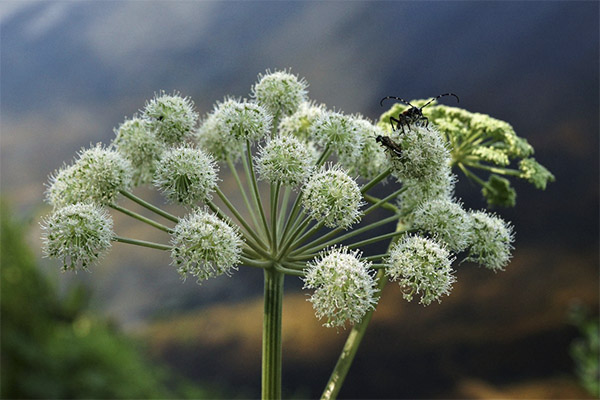
The main component of the oil is monoterpenes, or natural hydrocarbons with antiseptic, anti-inflammatory and antispasmodic effects. The oil's recognizable odor is given by legustilide, a substance that facilitates blood circulation, and sedanolide, which has antioxidant power.
Also in the composition of angelica is compounds such as falcarinol, falcarindiol. These are active photosensitizers - that is, substances that help increase the sensitivity of tissues to the effects of sunlight. They are also characterized by anti-inflammatory, anticoagulant, antibacterial, anti-tuberculosis, antifungal, antiviral, neuroprotective and immunostimulating properties.
There are also organic acids, resins, tannins, wax and sugar. The leaves and flowers of the plant contain flavonoid diosmin, which has vasoconstrictor ability. The seeds contain coumarins - biologically active substances with a wide range of pharmacological activity. They can manifest themselves as antispasmodic, antitumor, anticoagulant agents.
How it looks and where it grows
It is impossible not to pay attention to angelica. Its large inflorescences on tall stems with beautiful carved leaves are sure to attract attention. Biologists call this form of inflorescence a complex umbrella, the diameter of which can range from 8 to 15 cm, although each individual flower is small and unsightly, with elongated petals of whitish or yellowish-greenish color and absolutely invisible calyxes. angelica blooms from June until August, after which each plant may produce up to half a thousand seeds.
In the first year, when a young plant grows from seed, it produces only a root and a root rosette consisting of a bunch of leaves. The following year, a tall stem with attractive leaves and large, prominent inflorescences grows from the root.
The stalk with a blue scum can reach a height of up to 2.5 m. It is absolutely hollow inside (for this reason it is popularly called a dudka or puffin), straight underneath, branching out closer to the top.
The stem has leaves, which are pinnately dissected, large, sharp-toothed at the ends. The lower leaves can be up to 80 cm long, the upper ones shorter. They sit on the stem alternately, attached to hollow petioles.
Rhizome of angelica is thick (up to 10 cm thick), going vertically into the ground. It has adventitious roots on top, transforming into a tap root below. Inside the root is a light yellow sap, or secret, as botanists say.
It can be found practically in any region of Northern and Central Europe, in Russia - in all areas of the European part of the country from the coast of the Barents Sea to the middle belt and the Ural Mountains. In some places it grows in Western Siberia, you can also see it in the North Caucasus. The plant prefers damp but not badly illuminated places, ravines, waterlogged places in woods, near bushes and along rivers; it may form dense rich thickets - complete colonies. Soils it likes neutral or weakly acidic.
Elm is an excellent honeycomb and a very unpretentious plant. Therefore, if desired, it is easy to grow it in the country house. To do this, it is better to sow it in the fall.
Collection and storage
In angelica for medicinal purposes, all parts of the plant are collected - from greens and seeds to the root. But the rhizomes and seeds of angelica have a particular value. Both are harvested when the seeds are already mature.
The umbrellas are harvested and hung to dry in bunches, just like the green parts of the plant. They dry best on a veranda or under a canopy. When the inflorescences are dry, the seeds are ground from them.
The roots are dug out, well washed with a brush, cut lengthwise and dried in a dryer. If it is dry in sunny weather, you can dry in the air, avoiding direct sunlight. Arrange the raw material in a single layer on a clean paper and occasionally stir for more even discussion. Raw material to finally dry will need at least 10 days.
Process angelica should be careful. Its juice contains substances that in contact with the skin many times increases its sensitivity to light, resulting in redness of the skin and even blisters.
Store seeds and roots separately, in dry glass jars with well-frictioned stoppers, since the raw material easily absorbs moisture, after which it loses all its aromatic properties. If you follow the rules of storage angelica root does not lose its useful qualities for three years. In dried greens, the period is much shorter - no more than a year.
What is the difference between angelica and milk thistle
When collecting angelica, it is important not to confuse it with the milk thistle. The milk thistle is a poisonous plant. If its sap gets on the skin, it will be covered with dark spots and blisters, which heal very poorly, long and slow. In order not to suffer from a dangerous plant, you need to remember a few differences.
- First, borage, if its leaf is torn, begins to smell very unpleasant. Muskmelon, on the other hand, has a very pleasant aroma.
- Secondly, the stalk of angelica is absolutely smooth, blue-red closer to the ground, while that of hogweed is absolutely green, maybe closer to straw-green, completely covered with stiff hairs.
- Thirdly, the inflorescences of the broomstongs are also covered with stiff hairs, while those of angelica are not.
- Fourthly, angelica leaves are located on the stem, while the milkweed leaves form a root rosette. In addition, the general appearance of each individual leaf fragment is closer to an oval, while that of the angelica has a pronounced carved shape.
Medicinal properties of angelica
As a medicinal plant, angelica is used for a very long time. There is a beautiful legend that says this plant was sent by God to the inhabitants of northern Europe, where at this time plague ravaged. An angel came down from heaven and brought the saving angelica root. Since then, the plant became known as archangelica, later this word was simplified to angelica.
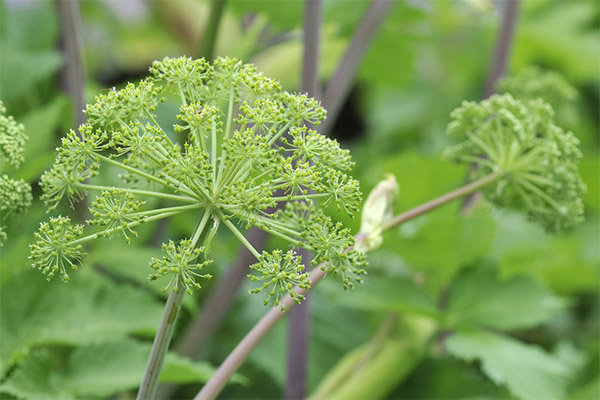
In fact, of course, angelica could not cure the plague. Scientists believe that the patients survived due to the fact that angelica activated the immune system and showed its anti-inflammatory and antiseptic effects.
Medicine - both folk and official - recognize and appreciate angelica for its extensive list of versatile beneficial properties. It has the ability to stimulate blood circulation, enhance immunity, it has anti-inflammatory, expectorant, diaphoretic, diuretic, antispasmodic, anti-fermentation effects. This medicinal plant normalizes the cardiovascular and nervous systems, improves blood circulation, bile and pancreatic juice production, reduces blood pressure. It is used as a rub for lower back pain, gout and rheumatism. Elm has the ability to reduce cholesterol, stabilize the uterus and the entire female reproductive system. Because of its antiseptic properties, it is used for cystitis and for cosmetic problems.
In addition, angelica also has a good calming and tonic effect, and it is sometimes recommended instead of valerian root.
For women
For women's health, angelica is very useful and has long been used not only in Russia, but, for example, in China. It has even been given the informal name "female ginseng". Since it has the ability to relieve spasms and dilate blood vessels, compositions of this plant are recommended to get rid of pain during menstruation.
During menopause angelica is also used, because it has the ability to normalize the level of estrogen in the female body, as a result of which it relieves the unpleasant symptoms of hot flashes.
Active use of angelica and polycystic fibrosis, uterine myoma, endometriosis, during menstruation to reduce too much blood. With its help also restore the cycle, disrupted by prolonged intake of hormonal contraceptives.
angelica also helps with infertility, if its cause is poor blood supply to the pelvic organs, as is often the case in women suffering from anemia or those whose working day is associated with hours of sitting in the same position in a stuffy office. Angiata can help solve these problems.
For men
The ability of angelica to adjust hormonal levels also applies to men. Thus, it not only returns manhood, but also prevents disorders of the heart and blood vessels and helps restore lipid metabolism.
By affecting blood circulation, the plant improves microcirculation and in the genitals, which helps to restore potency. To do this you only need to drink ready-made angelica tea, bought in the pharmacy and packaged in disposable bags. Anti-inflammatory and antibacterial abilities of the plant will help with infections and inflammatory processes of the genitourinary system.
For weight loss
Since angelica has the ability to activate all processes of the body, for weight loss use its positive effect in improving metabolism. Visible results can be obtained if you apply the plant simultaneously with sports and dietary activities. Elm will not only help to reduce weight, but also calm the nervous system, remove the fixation on the problem of weight loss.
It is recommended to use it in the form of alcoholic tinctures in course receptions for a month, after which to take a two-month break. You can also try a non-alcoholic version in the form of infusion. These remedies help to fight cellulite and fat deposits.
Angelica in folk medicine
With the help of angelica root treat many diseases. For each of them there are different recipes that are most suitable in certain cases. Different dosage forms are also used, such as tinctures, infusions, decoctions, teas, and even oil.
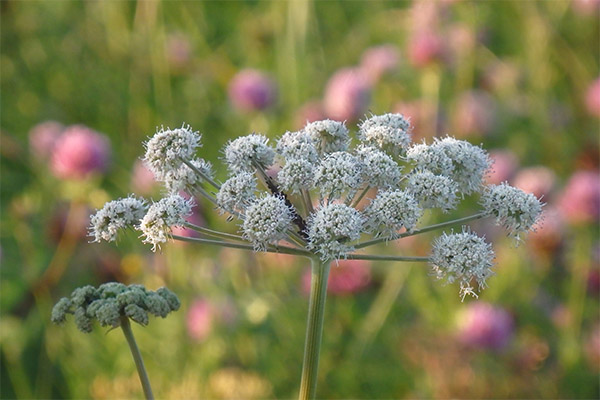
Thus, folk healers keep many recipes used to heal patients suffering from respiratory diseases. Essential oil from the roots of the plant is widely used to treat bronchitis, viral infections, even for the common cold. Women widely use the oil to restore a disrupted menstrual cycle, during menopause.
Taking alcoholic tincture internally relieves pain in suffering from osteoporosis, rheumatism. The same tincture can also be used outside, rubbing the lower back and joints. This method of treatment is also effective.
Decoction reduces sugar, uses it for asthma, intestinal problems - such as colic, congestion, obstruction, diseases of the excretory system (inflammation of the bladder, kidney infections). If you make a decoction of angelica with honey, get an excellent diaphoretic. It can also be used when you have problems with urinary retention.
Infusion of angelica - a good help in the treatment of periodontal disease, laryngitis, pneumonia, gastritis, pancreatic and liver dysfunction, urolithiasis. Due to the ability to establish blood circulation, this remedy has proven to be good in the treatment of infertility. The infusion is recommended to add to the water when taking baths, if the patient is diagnosed with such diseases as neuralgia, gout and nervous exhaustion. Good such baths are also if tortured insomnia, aching joints, can not heal scratches and wounds on the skin or exacerbated skin manifestations of psoriasis or dermatitis.
Folk medicine has even learned to use angelica juice. It is prescribed if toothache or earache becomes unbearable, and also put into the nose in case of rhinitis. Mixing the juice with pig fat and angelica oil to make ointments that drive out lice.
Dried and powdered leaves, mixed equally with honey, can be used for dressings on wounds, since angelica is a wound-healing agent. Also herb has anthelmintic properties, for which a tablespoon of dried herbs poured in 300 ml of white wine and insist a day, occasionally shaking. Then this mixture is strained and drunk before eating 2 spoons 2 times a day.
Types of medicinal compositions
Infusion
- An expectorant. A teaspoon of powdered dried rhizomes poured into a thermos and pour there the same 2 cups of boiling water, cover and insist 6 to 8 hours. Drink this infusion 3 to 4 times a day for half an hour before a meal and half a cup. Used as a diaphoretic and expectorant for bronchitis and laryngitis, as well as antispasmodic composition in spasms of smooth muscles.
- Soothing remedy. Powder of dry rhizomes (1 tablespoon) pour boiling water (1 cup), insist under a lid for half an hour. Drink such a remedy after straining 3 times a day before meals, at a time for 2 tablespoons. Acts as a sedative, helps relieve nervous irritability, eliminates insomnia, relieves coughs, but also works well with delayed urination.
- For infertility. A tablespoon of angelica root is mixed with 250 ml of boiling water and infused for several hours. Then the resulting mixture is well strained, divide the liquid in half and drink in a day: morning and evening.
- Herbal infusion for gastritis. 200 ml of water with a tablespoon of dried angelica herb is brought to a boil. Insist for about 5-6 hours. After straining take 4 times a day before meals 2 spoonfuls of infusion. Recommended in the treatment of gastritis with hyperacidity, colitis, as well as for the normalization of sleep with insomnia.
Tincture .
- Tincture in alcohol. To prepare the tincture, 200 ml of good vodka or diluted alcohol are mixed with 3 full tablespoons of angelica root powder. Put for 10-12 days in a dark room, then strain. Apply such a tincture by teaspoon no more than 3 times a day for digestive problems, gastritis, flatulence, as well as to normalize the activity of blood vessels and respiratory system. It can be drunk by those who want to lose weight. It will help to relieve muscle and joint pain. To do this, make rubbing with an alcoholic tincture.
- Water tincture. Water tincture is an option for those who cannot tolerate alcohol, including it can be given to children. Take this tincture for the same health problems as alcohol. Three tablespoons of the root pour 200 ml of boiling water, infused for a day and filtered. Drink a tablespoon three times a day.
Decoction .
- Decoction with honey. A tablespoon of crushed dry angelica root is boiled for 5 minutes with a glass of water, leave to infuse for another 2 hours. After straining, drink 1/4 cup with honey. Indications - cough, chronic pancreatitis or gastritis.
- For recuperation. 3 tablespoons of angelica rhizomes pour a glass of cold water and put to boil for 10 minutes. Then turn off the heat and infused for another 20 minutes. This product is drunk 2-3 times a day before a meal with desiccation and loss of strength, the norm - half a cup.
- Diuretic decoction. A tablespoon of seeds for 5 minutes boiled in half a liter of water. Cool and strain when the seeds sink to the bottom. Drink 100 ml 5 times a day. To make the drink tastier, add a dash of honey. Decoction has a strong diuretic effect.
Tea
In addition to angelica rhizome, take chamomile, willow tea, rose hips, St. John's wort, you can add other favorite herbs. All the ingredients are mixed in equal proportions, and then brewed and drunk as usual delicious and incredibly fragrant tea. Such a drink has a wonderful tonic effect, and it is also useful for stomach disorders of a neurogenic nature.
Oil of angelica: properties and contraindications
Essential oil is in all parts of the plant, but in industrial processing only the seeds and roots are used, since there the most of this valuable product. For its extraction use the method of steam distillation.
The oil from the roots is used as a tonic and cleansing agent, has a diaphoretic and anti-toxic effects, allowing the body to normalize the balance of trace elements, particularly potassium. This has a beneficial effect on the cardiovascular system.
It is also useful in the treatment of diseases of the digestive system. Due to its ability to normalize the hormonal background of a woman, the oil is used to stabilize the menstrual cycle, and the antispasmodic properties of the product help to get rid of pain during menstruation.
In addition, this oil is a strong antiseptic, which also gives the opportunity to use it in gynecology, as well as to relieve patients suffering from pain of rheumatic nature. A few drops of angelica oil mixed with a little olive oil is used to treat coughs, the mixture is rubbed on the skin around the bronchi, which helps to thin the phlegm. Add the essential oil and inhalation, if you have a runny nose and stuffy throat. Such a procedure helps to recover faster.
Oil from the seeds are added to food for flavoring. But most often it is used for cosmetic and perfumery purposes, because it has an excellent ability to improve the condition of the skin. It is simply added a few drops to creams and lotions. With regular use, it can cure irritation, get rid of blackheads, and give the skin a more youthful appearance.
Although the oil is not considered an allergenic or toxic product, its individual intolerance is quite possible. Therefore, before you start active use, it is necessary to check whether there will be a negative reaction to it. To do this, you need to apply it to your wrist on the inside.
In addition, the oil stimulates the contractile activity of the uterus, so it is contraindicated for pregnant women to avoid miscarriage. For the same reason, nursing mothers should not use the drug, in them it can cause bleeding. Also, you should not use the oil to treat babies under two years of age.
Useful properties of angelica honey
Despite the fact that the word of mouth attributes a lot of amazing medicinal properties to angelica honey, it is not widespread. It is appreciated for its unusual subtle and delicate aroma, interesting color, which can be both amber-red and dark brown with a greenish hue, rich exquisite taste with a caramel note. This honey is considered a high-grade, elite honey. It practically does not crystallize, but simply becomes thick and viscous over time.
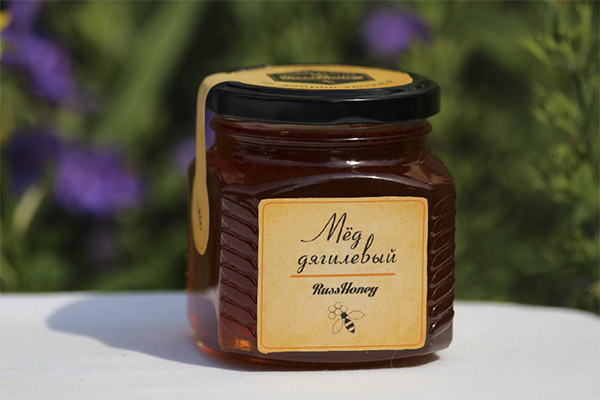
The composition of honey has been studied quite well. It has been proven that fructose (about 43%) rather than glucose makes up the majority of its composition. Therefore, angelica honey after consultation with a doctor is allowed to use even with diabetes, but in small quantities.
In addition to the traditional honey glucose, maltose and sucrose, the angelica product has a whole complex of all the major vitamins, enzymes and trace elements necessary for humans. There are fungicides in honey, which help in the fight against bacterial and fungal infections, as well as natural antiseptics that inhibit the development of pathogenic microflora, so it is an excellent remedy in the treatment of bronchitis, acute respiratory infections and SARS, angina and cystitis. In addition, honey has the ability to strengthen the immune system, which makes it useful during the slushy and cold autumn and winter season, and especially for people who are weakened, had surgery, serious illness. It will help regain strength tired and exhausted by hard work - both physical and mental. Honey promotes healing of wounds on the mucous membranes, supports heart and vascular function.
Women can use it to restore normal menstrual cycle, as a preventive measure against thrush. Honey has been proven to activate lactation, but since it causes allergies in children, breastfeeding mothers should avoid using it.
The effectiveness of honey has also been proven for cosmetic procedures. So, if you put it on your face, like a mask, it will tighten the skin and give it a more youthful appearance. You can use angelica honey, preparing on its basis home scrubs. Wraps with honey accelerate getting rid of cellulite, because they improve blood circulation, nutrition and, accordingly, remove excess fat and toxic substances.
It is useful to consume angelica honey in the evening: it has the peculiarity to soothe the body. A spoonful or two of sweet product with tea will ensure a healthy sleep.
However, you should not overdo it. Since it is quite caloric (328 calories in 100 grams), an adult for preventive purposes 50-60 grams per day is enough, and during the disease - no more than 100 grams.
In order not to buy a fake instead of natural angelica honey, you need to remember that this product does not come cheap. Its price should be very high compared to other varieties of honey. For the same purpose, you can conduct an experiment to determine its flammability. If when heated on a fire in a spoon it did not change the consistency and caught fire - then it is a fake.
Honey like this can be stored for years. The main thing is to keep it in a glass container in a dark room at a temperature no higher than 20 degrees, avoiding contact with metal, so that a valuable product does not oxidize.
The use of angelica in cosmetology
Cosmetology most often uses the antibacterial and anti acne properties of angelica. To become beautiful, you can use it both as an external remedy and as an internal one.
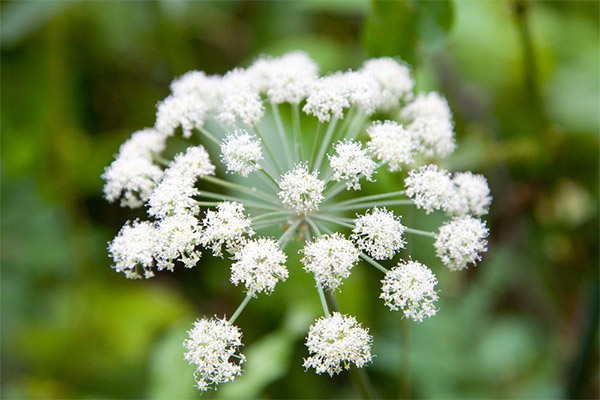
To relieve irritation or rejuvenate the skin, the essential oil has proven excellent. Alcoholic tincture often becomes the basis for an anti-inflammatory lotion. In addition, the oil promotes rapid healing of scars, wounds, microcracks, cuts, resorption of bruises and bruises. The oil can be used as an independent product, applying it to the skin, as well as adding it to creams, ointments, masks, balms for hands, feet and hair, shampoos.
Decoction of angelica is able to transform tired skin, especially if you make it into ice cubes and then wipe your face with them.
Since angelica contains a significant amount of coumarin, it has the ability to improve blood microcirculation in the skin, which stimulates its active regeneration and regeneration of tissues. That is, angelica can be used to rejuvenate the skin. This property eu it is pronounced and powerful.
In a number of compositions angelica is used to achieve a skin lifting effect. In addition, it also promotes the production of collagen protein, which allows it to be used as a smoothing mask for the skin, as well as therapeutic compositions for hair.
To reduce skin irritation
Scald the crushed root (1 teaspoon) with a glass of boiling water and leave the medicine in this water for 10 minutes, then strain. Wash your face in the morning and evening, you can simply wipe with a cotton pad soaked in this composition.
To get rid of fine lines and wrinkles.
Prepare a decoction of angelica root: boil 3 tablespoons of raw materials in 250 ml of water for 20 minutes, then insist the same time. Strain, take a teaspoon of the composition, mix with a teaspoon of honey and a tablespoon of cottage cheese. As you need to knead, put it on your face and lie down to rest for 10-15 minutes. Then wash off the mask with warm water and rinse your face with cool water.
Bath for firm and smooth skin
Boil a liter of boiling water 2 tablespoons of ground angelica root. Influence 20-30 minutes and after straining pour the resulting infusion into the bath. Take a quarter of an hour bath, with the water should not be very hot. For the result to be more noticeable, to take a course of such baths - from 10 to 15 procedures.
Hair Smoothing Mask
Wash your hair with regular shampoo. Apply ready-made store mask to the hair, in which a drop of angelica essential oil - 2-3 drops will be enough. Wait 2-3 minutes, then rinse. Hair will become noticeably smoother and shinier. Repeat the procedure for a two-week course, using the mask after each wash.
For more lush hair
Prepare a decoction of angelica root: pour 5 tablespoons of dry raw materials in 2 liters of water. Boil the mixture for about 10 minutes, infuse for another half an hour. Strain, add another 1.5 liters of water and rinse your hair after washing. Decoction helps to get rid of dandruff, makes hair lush and gives it a pleasant fragrance.
Contraindications for use
It is said that you can get spots from the sun too. The same is true for angelica: with all its benefits and a huge number of excellent medicinal properties, this plant can be dangerous in some cases. So, it categorically should not be used by pregnant women, and at any stage of pregnancy. Nursing mothers should also not try to treat angelica.
It is also contraindicated if prone to bleeding (especially severe uterine bleeding). Peptic ulcer, tachycardia and diabetes are also contraindications to the use of angelica.
There are people in whom the juice of the plant provokes an allergic reaction, that is, individual intolerance of compositions based on angelica cannot be excluded.
But even if at therapeutically reasonable doses, the body responds positively to the reception of angelica, then in overdose, the typical signs of poisoning may appear: photophobia, diarrhea, dizziness, nausea, vomiting, loss of consciousness and even paralysis.
«Important: All information on this site is provided for informational purposes only. for informational purposes only. Please consult with your health care professional before using any of the recommendations. specialist before using any of the recommendations. Neither the editors nor the authors shall be liable for any possible harm caused by materials."



